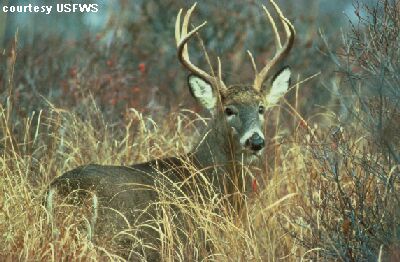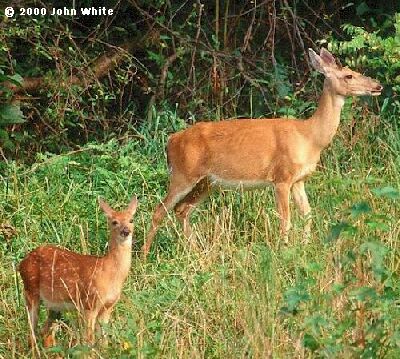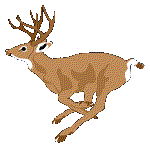THE |  |
|---|
Where they live?
Appearance
Males have large antlers that make them look taller. They shed the antlers in the winter but a new set grows in the summer.  In the summer the back and sides of the deer's coat are brown. In the winter the brown coat turns greyish. The stomach and insides of the legs are white. The underside of the tail is white.
 Food Deer eat grasses and leaves. They will also eat mushrooms and berries. In the winter deer nibble on twigs and buds. Deer also eat the grain that is left in farmers' fields after the harvest. The white-tailed deer eats its food twice. It has four stomachs. The deer starts eating early in the morning. It gobbles down grass and leaves to fill the first stomach. Then while it takes a rest the food goes into the second stomach where it turns into little balls. Now the deer can bring the food back up to its mouth and chew it well. The chewed food goes to the third and fourth stomachs. 
The young a spotted fawnA buck fawn (young male) has bumps on his skull where the antlers will grow. Enemies Man, the wolf, lynx, coyote, bobcat and cougar are the deer's enemies. Even though a deer is very fast a pack of wolves or coyotes is able to catch them. The deer cannot run fast if the ground is covered with deep snow. The deer's thin legs sink into the deep snow. a deer in the snowWhen the deer is alarmed it raises its tail like a flag and dashes away. The flash of white fur warns the other deer.
 Deer have a keen sense of smell, good hearing and good eyesight. With its antlers and sharp hooves the male deer can sometimes kill a wolf. It will butt the wolf with its horns and then stamp on it with its feet. To prepare for the winter deer grow a thick coat and eat alot of food to store up body fat. If it is a very long and cold winter deer may gather in small groups for protection from the cold.
images: (deer1.jpg, deer4.jpg) Copyright © 2000 John White
J.Giannetta |